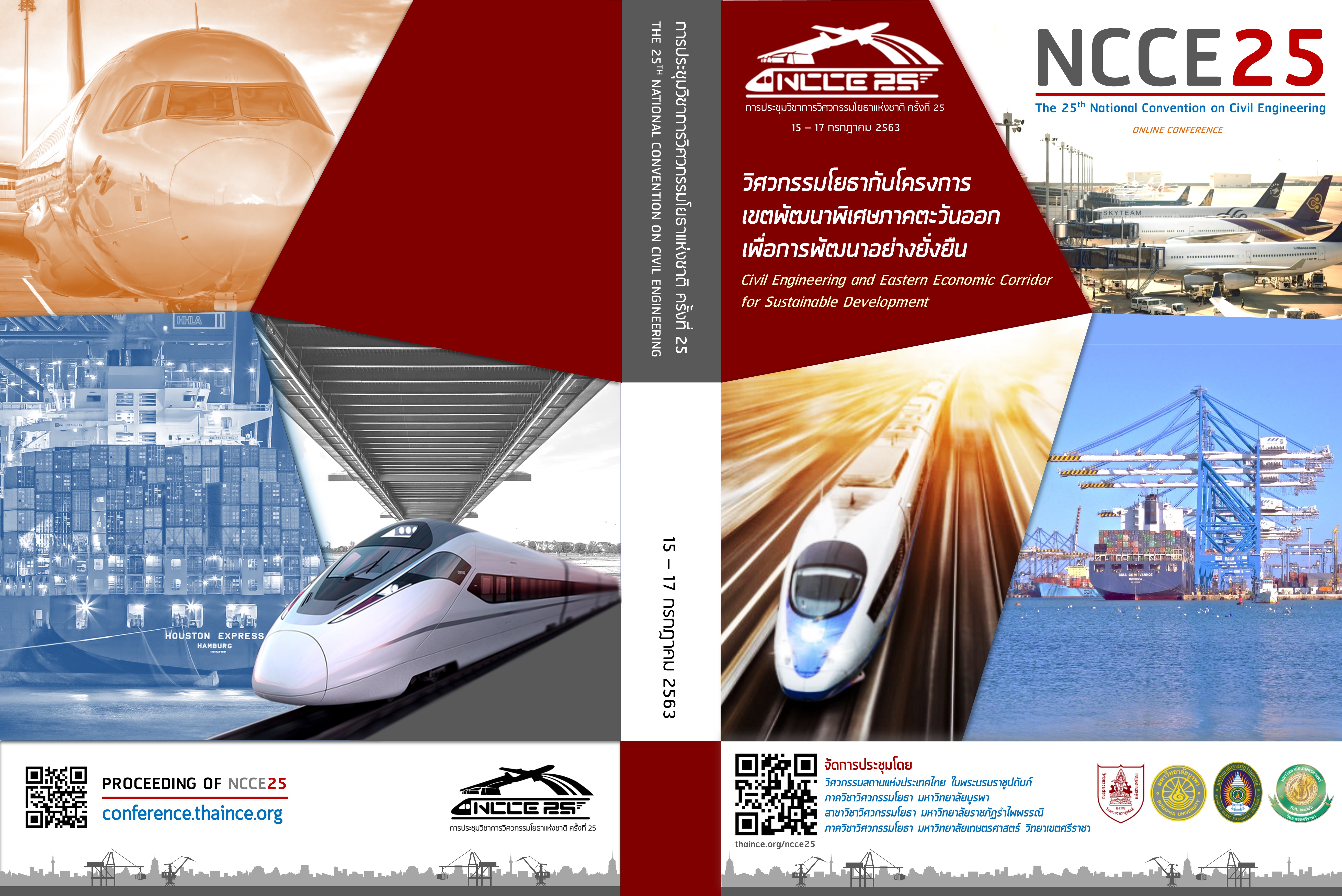ผลกระทบของอุณหภูมิและความชื้นสัมพัทธ์ต่อปริมาณคลอไรด์วิกฤตของคอนกรีต
คำสำคัญ:
ปริมาณคลอไรด์วิกฤต, ระยะเวลาเริ่มเกิดสนิม, อุณหภูมิ, ความชื้นสัมพัทธ์, เถ้าลอย, ซิลิก้าฟูมบทคัดย่อ
บทความนี้มุ่งศึกษาผลกระทบของอุณหภูมิและความชื้นสัมพัทธ์ของสิ่งแวดล้อมต่อปริมาณคลอไรด์วิกฤตของคอนกรีต โดยศึกษาอุณหภูมิของสิ่งแวดล้อมที่ 30°C และ 50°C และความชื้นสัมพัทธ์ของสิ่งแวดล้อมที่ 30% และ 90% ในการศึกษานี้ใช้อัตราส่วนเถ้าลอยต่อวัสดุประสาน 0.20 และ 0.40 อัตราส่วนซิลิก้าฟูมต่อวัสดุประสานเท่ากับ 0.075 ใช้อัตราส่วนน้ำต่อวัสดุประสานเท่ากับ 0.50 สำหรับทุกส่วนผสม จากผลการศึกษาพบว่า เมื่อ ความชื้นสัมพัทธ์คงที่ 90% คอนกรีตที่เผชิญอุณหภูมิสิ่งแวดล้อม 30°C มีระยะเวลาเริ่มเกิดสนิมของเหล็กเสริมนานกว่าคอนกรีตที่อุณหภูมิ 50°C แต่มีปริมาณคลอไรด์วิกฤตของคอนกรีตต่ำกว่า ในขณะที่เมื่ออุณหภูมิคงที่ 50°C คอนกรีตที่เผชิญความชื้นสัมพัทธ์สิ่งแวดล้อม 30% มีระยะเวลาเริ่มเกิดสนิมนานกว่าคอนกรีตที่เผชิญความชื้นสัมพัทธ์สิ่งแวดล้อม 90% แต่มีปริมาณคลอไรด์วิกฤตที่ต่ำกว่าเช่นกัน หากพิจารณาดัชนีความต้านทานการเกิดสนิมของเหล็กเสริมในคอนกรีต (CRIDT) พบว่า คอนกรีตที่เผชิญอุณหภูมิสิ่งแวดล้อมต่ำมีค่า CRIDT มากกว่าคอนกรีตที่เผชิญอุณหภูมิสิ่งแวดล้อมสูง และคอนกรีตที่เผชิญความชื้นสัมพัทธ์ต่ำมี CRIDT มากกว่าคอนกรีตที่เผชิญความชื้นสัมพัทธ์สูง คอนกรีตที่ใช้เถ้าลอยแทนที่วัสดุประสานร้อยละ 40 มีค่า CRIDT มากที่สุด คอนกรีตที่ใช้ซิลิก้าฟูมแทนที่วัสดุประสานร้อยละ 7.5 มีค่า CRIDT สูงกว่าคอนกรีตซีเมนต์ล้วน
Downloads
เอกสารอ้างอิง
[2] Tangtermsirikul, S. (2003). Durability and mix design of concrete (1st edition). Pathum Thani: Thammasat University, Rangsit Campus.
[3] Jones, M.R., Dhir, R.K. and Gill, J.P. (1994). Concrete surface treatment: Effect of exposure temperature on chloride diffusion resistance. Cement and Cement Research, 25(1), pp. 197-208.
[4] Gastaldi, M. and Bertolini, L. (2014). Effect of temperature on the corrosion behaviour of low-nickel duplex stainless steel bars in concrete. Cement and Concrete Research, 56, pp. 52-60.
[5] Angst, U., Elsener, B., Larsen, C.K. and Vennesland, Q. (2009). Critical chloride content in reinforced concrete - A review. Cement and Concrete Research, 39, pp. 1122-1138.
[6] Tuutti, K. (1982). Corrosion of steel in concrete. Swedish Cement and Concrete Research Institute, Stockholm.
[7] American Society for Testing and Materials (ASTM). (2000). ASTM C876, Standard test method for half-cell potentials of uncoated reinforcing steel in concrete.
[8] American Society for Testing and Materials (ASTM). (2000). ASTM G109, Standard test method determining the effects of chemical admixtures on the corrosion of embedded steel reinforcement in concrete exposed to chloride environments.
[9] British Standards (BS). BS 1881-116, Method for determination of compressive strength of concrete cubes.
[10] American Society for Testing and Materials (ASTM). (2000). ASTM C1152, Standard Test Method for Acid-Soluble Chloride in Mortar and Concrete.
[11] Ann, K.Y. and Song, H.W. (2007). Chloride threshold level for corrosion of steel in concrete. Corrosion Science, 49, pp. 4113-4133.
[12] Thomas, M. (1996). Chloride thresholds in marine concrete. Cement and Concrete Research, 26, pp. 513-519.
[13] Thomas, M.D.A. and Matthews, J.D. (2004). Performance of pfa concrete in a marine environment-10 year results. Cement and Concrete Composites, 26, pp. 5-20.
[14] Hussain, S.E. and Rasheeduzafar, S. (1994). Corrosion resistance performance of fly ash blended cement concrete. ACI Material Journal, 91, pp. 264-273.
[15] Bamfort, P.B. (1999). The derivation of input data for modelling chloride ingress from eight-years UK coastal exposure trials. Magazine of Concrete Research, 51, pp. 87-96.
[16] Dehwah, H.A.F., Austin, S.A. and Maslehnddin, M. (2002). Chloride-induced reinforcement corrosion in blended cement concretes exposed to chloride-sulphate environments. Magazine of Concrete Research, 54, pp. 355-364.
[17] Arya, C., Buenfeld, N.R. and Newman, J.B. (1990). Factors influencing chloride-binding in concrete. Cement and Concrete Research, 20, pp. 291–300.
[18] Dhir, R.K. and Jones, M.R. (1999). Development of chloride-resisting concrete using fly ash. Fuel, 78, pp. 137–142.
[19] Kayyali, O.A. and Haque, M.N. (1995). The Cl/OH ratio in chloride-contaminated concrete - a most important criterion. Magazine of Concrete Research, 47, pp. 235–242.
[20] Page, C.L. and Havdahl, J. (1985). Electrochemical monitoring of corrosion of steel in microsilica cement pastes. Materials and Structures, 18, pp. 41–47.
[21] Page, C.L. and Vennesland, Ø. (1983). Pore solution composition and chloride binding capacity of silica fume-cement pastes. Materials and Structures, 19, pp. 19–25.
[22] Larsen, C.K. (1998). Chloride binding in concrete. Thesis, Report No 1998:101, Norwegian University of Science and Technology, NTNU.
[23] Byfors, K. (1987). Influence of silica fume and fly ash on chloride diffusion and pH values in cement paste. Cement and Concrete Research, 17, pp. 115–130.
[24] Glass, G.K. and Buenfeld, N.R. (1997). The presentation of the chloride threshold level for corrosion of steel in concrete. Corrosion Science, 39(5), pp. 1001–1013.
[25] Shehata, M.H., Thomas, M.D.A. and Bleszynski, R.F. (1999). The effects of fly ash composition on chemistry of pore solution in hydrated cement pasted. Cement and Concrete Research, 29, pp. 1915-1920.
[26] Diamond, S. (1981). Effects of two Danish fly ashes on alkali contents of pore solutions of cement-fly ash pastes. Cement and Concrete Research, 11, pp. 383-394.
[27] Manera, M., Vennesland, Q. and Bertolini, L. (2008). Chloride threshold for rebar corrosion in concrete with addition of silica fume. Corrosion Science, 50, pp. 554-560.
ดาวน์โหลด
เผยแพร่แล้ว
วิธีการอ้างอิง
ฉบับ
บท
การอนุญาต
บทความทั้งหมดที่ได้รับการคัดเลือกให้นำเสนอผลงานในการประชุมวิชาการวิศวกรรมโยธาแห่งชาติ ครั้งที่ 25 นี้ เป็นลิขสิทธิ์ของ วิศวกรรมสถานแห่งประเทศไทย ในพระบรมราชูปถัมภ์



